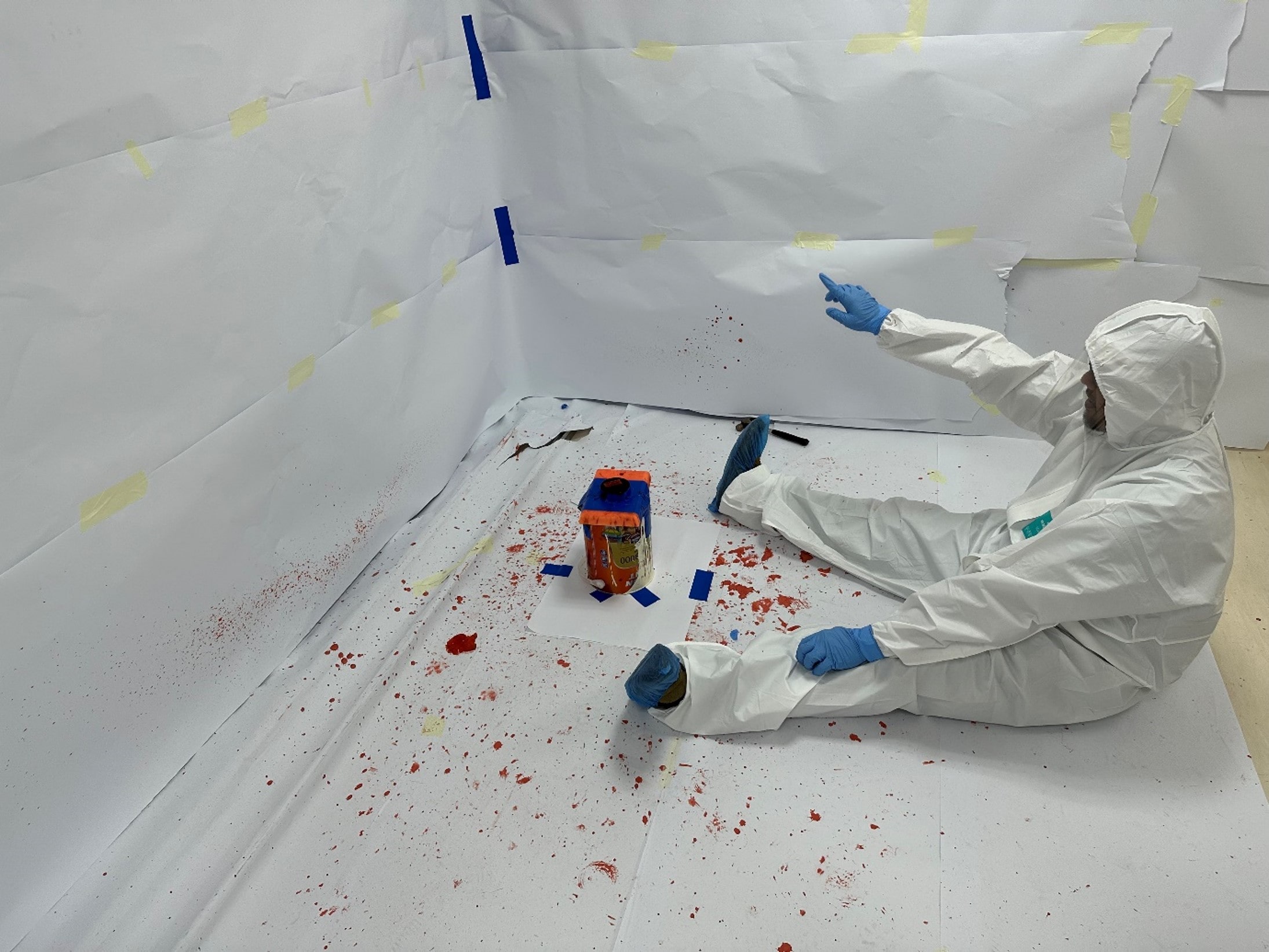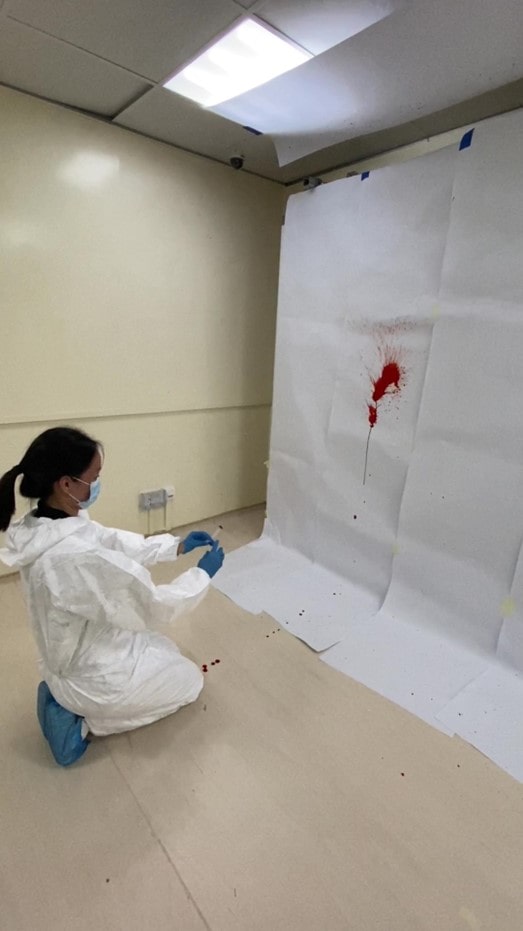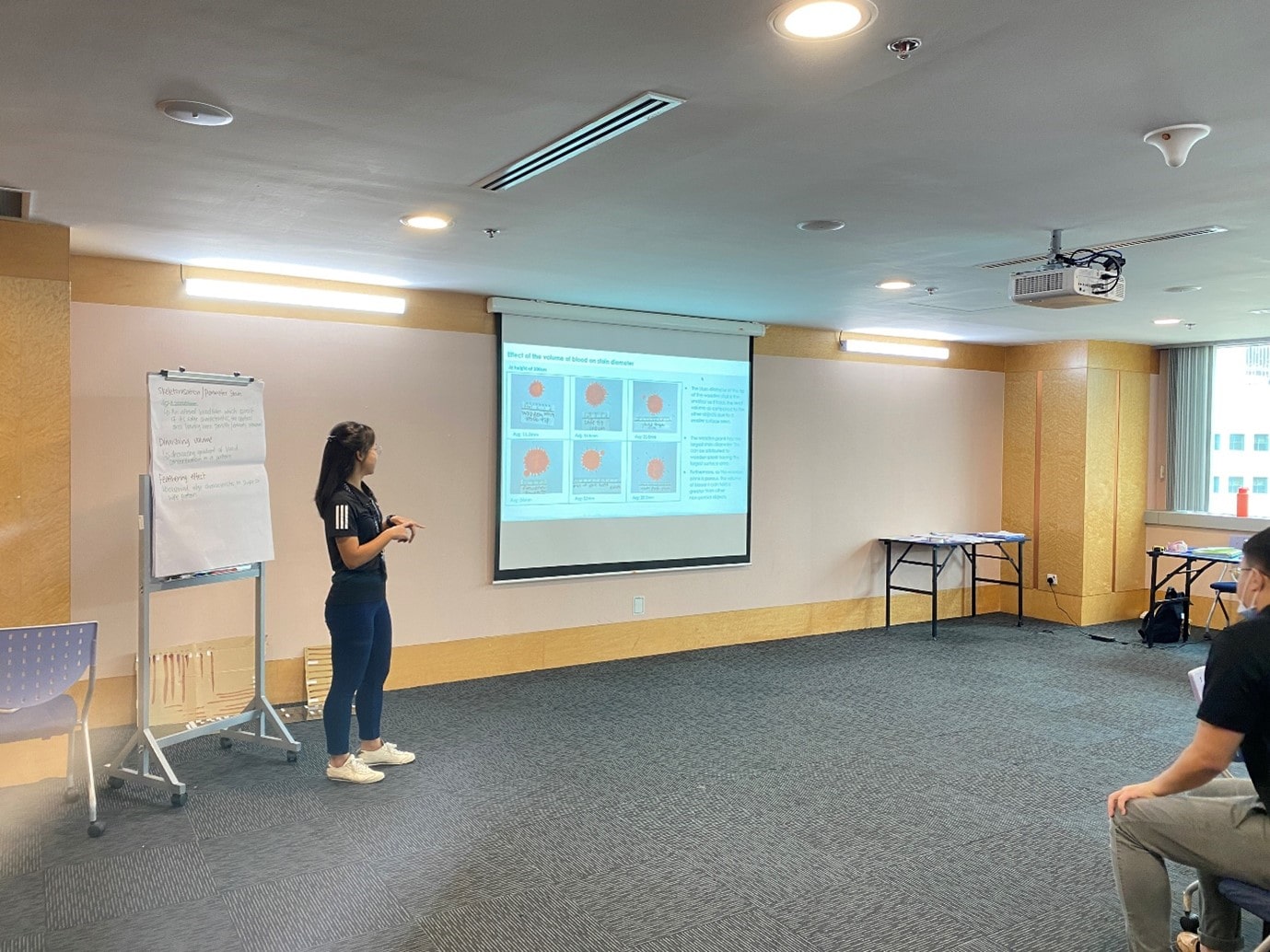 A participant creating impact patterns using different objects and observing how various factors such as the surface of the object, force, and blood volume, affect the distribution of bloodstains. (Photo: SPF)
A participant creating impact patterns using different objects and observing how various factors such as the surface of the object, force, and blood volume, affect the distribution of bloodstains. (Photo: SPF)
Imagine you’re investigating a bloody crime scene. The suspect claims the deceased victim had accidentally stabbed himself during the fight. Is the suspect telling the truth? If you know how to conduct Bloodstain Pattern Analysis (BPA), you will be able to study the shape, size, distribution, and location of the bloodstains at the crime scene and reconstruct what happened. Using BPA, you can form a proper scientific interpretation of the bloodletting event – in this case the stabbing – including where and how the persons involved were positioned. Based on these insights, you will be able to find out whether the suspect had told the truth about the victim accidentally stabbing himself, or whether he in fact had stabbed the victim.
Trainees attending the fundamental Crime Scene Specialist course offered by the Forensics Division (FD) of the Singapore Police Force’s Criminal Investigation Department (CID) go through a half-day Mixed Reality BPA training developed by HTX’s Forensics Centre of Expertise (CoE) and Human Factors and Simulation CoE. This training session gives them a better appreciation of the bloodied crime scene using Mixed Reality before they go through the Basic BPA course and have physical hands-on practice with BPA techniques using real and synthetic blood.
 A participant creating projected patterns that may be observed in situations where someone suffers an injury to their artery. (Photo: SPF)
A participant creating projected patterns that may be observed in situations where someone suffers an injury to their artery. (Photo: SPF)
Previously, FD officers (who are forward-deployed HTX officers from Forensics CoE) received Basic BPA training from reputable external trainers. However, FD realised it was important to develop its own in-house Basic BPA course. As Senior Crime Scene Specialist Shawn Foo shared, “We have seen how overseas travel can be disrupted by situations such as COVID. If we were solely dependent on overseas training providers, there will be severe impacts to our training. An in-house course is thus important for HTX to ensure business continuity and succession.”
In 2018, the FD established a working group with the aim of creating an in-house Basic BPA course. This customised in-house course was designed to align with the FD’s crime scene processes, ensuring it meets Singapore’s local requirements. Over the next five years, enough FD officers achieved Advanced BPA certifications to make it possible for FD to conduct in-house Basic BPA training.
FD’s in-house Basic BPA course is a comprehensive 40-hour course which combines theoretical and practical training, allowing participants to create, observe, and document various bloodstain patterns. Hands-on training ensures that the participants can effectively identify and document bloodstain patterns in real crime scenes. It is a crucial milestone course for the FD’s Crime Scene Specialists and is a mandatory prerequisite for them to attend Advanced BPA courses.
Crime Scene Specialists who complete the Basic BPA course have the skills and knowledge to offer Investigation Officers (IOs) informed advice when assisting with their cases. In addition, IOs who attend the course have a deeper understanding and appreciation of bloodletting scenes, enabling them to comprehend the intricacies and challenges encountered by Crime Scene Specialists.
 A participant sharing her observations from the practical sessions. (Photos: SPF)
A participant sharing her observations from the practical sessions. (Photos: SPF)
The next goal for FD was to attain approval by the International Association of Bloodstain Pattern Analysts (IABPA) for the inclusion of the Basic BPA course in the IABPA’s online list of international Basic BPA courses. Why is this important? Senior Crime Scene Specialist Shawn Foo, who is a member of the working group, explained, “To have our course listed on the IABPA website signifies that our standards in BPA training and competency meets IABPA requirements and are thus aligned with other international forensic service providers.”
Despite the challenge of balancing their day-to-day operations with course development, the FD officers in the working group successfully compiled and submitted the application materials to IABPA, which promptly listed the course in March 2023. The detailed submission also received praise for meeting IABPA’s requirements. Shawn shared that when he learned of IABPA’s approval he felt “Ecstatic, with an absolute sense of satisfaction!”
What do trainees think of FD’s in-house Basic BPA course? Feedback from participants of the September 2023 course reflected a high level of satisfaction with the programme’s depth and efficacy. Participants noted that the course provided them with a solid foundational understanding of BPA, thereby enhancing their proficiency in identifying and documenting bloodstain patterns.
Senior Investigation Officers from CID’s Special Investigation Section (SIS) emphasised the course’s value in providing contextual insights into scene appreciation, and a deeper understanding of the challenges encountered by FD officers in the field. For example, SIS Senior Investigation Officer Sim Xiangwei “strongly recommended” the Basic BPA course and elaborated,
“I feel this course is highly relevant for investigation officers to get a deeper understanding of bloodstain patterns. Having this knowledge would aid you in building a picture of what probably happened at the crime scene for relevant cases. At the minimum, it gives you technical knowledge or reference to BPA reports that could be requested. Also, the many experiments conducted helped me re-live my academic years. The course was fun, interactive, memorable, and most importantly, enriching.”

